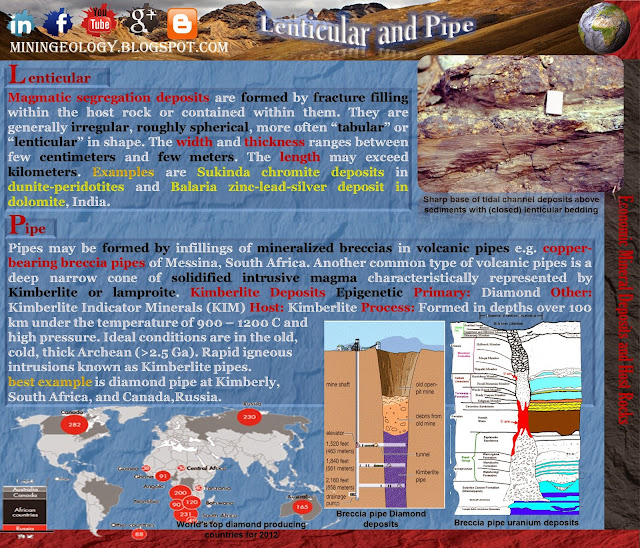 |
Layered”, “rhythmic” and “bedded” types of deposits are formed generally by deposition and consolidation of sediments that may or may not be metamorphosed. The type of ore deposit will depend on the composition of the transported sediments. The deposits showing
these features are iron ore (BHQ/BIF), lignite, and coal.
The layered and rhythmic features are also developed during the differential crystallization and segregation of the mafic and ultramafic
magma in a huge chamber over a prolonged time. The early crystallization, settling and consolidation of heavy metal-rich layers are composed of Cr-Ni-Cu-Pt-Pd and disseminated sulfides +,- Au and Ag forming economic mineral deposits. The late crystallization and solidification of residual magma form alternate layers of dunite, peridotite, gabbro and anorthosite. The process repeats with
addition of fresh magmatic cycles. The
examples are Bushveld
platinum-chromite deposits, South Africa, Sittampundi Cr-Pt-Pd, Sukinda Cr-Ni, India.
 |
| Layered Rhythmic Bedded |
Porphyry Ore Deposit
“Porphyry” is a diversity of igneous rock consisting of large-grained crystal such as quartz and feldspar scattered in a
fine-grained groundmass. The groundmass is composed of indistinguishable crystals (aphanites as in basalt) or easily distinguishable
crystals (phanerites as in granite).
Porphyritic refers to the texture of the rocks and suffix as granite-, rhyolite-, and basalt-porphyry. The porphyry deposits are formed by differentiation and cooling
of a column of rising magma in stages. In the process it leads to a separation of dissolved metals into distinct zones and responsible for forming rich
deposits of copper, molybdenum, gold, tin, zinc and lead in the intrusive rock itself. There are several
large porphyry copper deposits in the world:
Examples Chuquicamata
(690 Mt
at 2.58% Cu), Dexing
Cu-Au-Ag Distirct, South China, Escondida
and El Salvador, Chile, Toquepala, Peru, Lavender
pit, Arizona and Malanjkhand, India.
 |
| Porphyry Ore Deposit |
Lenticular Pipe
Lenticular
Magmatic segregation deposits are formed by fracture filling within the host rock or
contained within them. They are generally irregular, roughly spherical, more often “tabular” or “lenticular” in shape. The width and thickness
ranges
between few centimeters and few meters. The length
may
exceed kilometers. Examples are Sukinda chromite deposits in dunite-peridotites and Balaria zinc-lead-silver deposit in dolomite, India.
Pipe
Fissure-veins
Pipes may be formed by infillings of mineralized breccias in volcanic pipes e.g. copper-bearing breccia pipes of Messina, South Africa.
Another common type of volcanic pipes is a deep narrow cone of solidified intrusive magma characteristically
represented by Kimberlite or lamproite. Kimberlite
Deposits Epigenetic Primary: Diamond Other: Kimberlite Indicator Minerals (KIM) Host: Kimberlite
Process: Formed in depths over 100
km under the temperature of 900 – 1200 C and high pressure. Ideal conditions
are in the old,
cold, thick Archean (>2.5 Ga). Rapid
igneous intrusions known as Kimberlite pipes. Best
example is diamond pipe at
Kimberly, South Africa, and Canada,Russia.
 |
| Lenticular & Pipe Ore Deposit |












Nice and with perfections
ReplyDelete